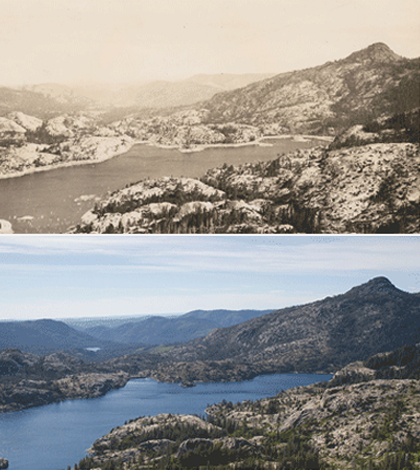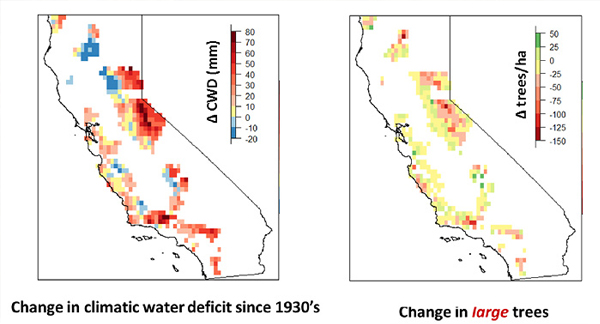Dry Conditions Reduce Number Of Large Trees In California Forests

Using a nearly trashed, century-old data set that was saved by librarians, scientists at the University of California, Berkeley, have led a study uncovering substantial shifts in the composition of California forests since the 1920s. Their discoveries are illuminating predictions of forest shifts that could come with future climate changes in the state and elsewhere.
Researchers at UC Davis and the U.S. Geological Survey chipped in to compare the old data set collected by Albert Wieslander, a UC Berkeley alumnus, in the 1920s and 1930s to recent data collected by the National Forest Service to make observations concerning changes to California forests. Their findings reveal that forests have gotten denser in the past 90-odd years, but most of the density is made up of small, young trees that have taken the place of large, older ones most likely impacted by drought conditions.
“The Forest Service goes out every decade to catalog and their methods are pretty different from how they were in the 1920s and 1930s,” said Patrick McIntyre, now an environmental scientist at the California Fish and Wildlife Service who led the study while still a postdoc at UC Berkeley. “The Forest Inventory and Analysis goes out with field crews, measures trees and cuts trees. In that way, it’s pretty similar to back in the ‘20s and ‘30s, but they (Wieslander) counted trees in different size categories and today’s data are much more defined in terms of tree height, width and core measuring.”
All those outdated methods were one reason that the extremely valuable data set, covering a third of all forests in California, almost wound up in the trash bin, says McIntyre. Thankfully, librarians within the University of California system who were getting ready to toss them noticed the old maps and charts and saved them from destruction. From there, they set out to digitize most of the information for historical preservation and future use.
The records proved useful to McIntyre’s investigation, as did pollen records from years ago that showed what sort of trees used to dominate California forests.

California’s water stress in the 1930s (left, red) and large tree declines (right, red) seen in the state since then. (Credit: McIntyre, et al.)
“If you go back in time about 100,000 years, during the warmer and drier periods, California was oak-dominated,” said McIntyre. “In the historical pollen record, when it was wetter, you’d see more pines.”
That sort of record has carried through to this day and age, says McIntyre, as he and the rest of the researchers noticed that California’s forests of today have come to be oak-dominated. But this doesn’t mean that the oaks are growing into giant, healthy trees with prospects of lives spanning centuries.
“Compared to ones from the thirties, today’s forests would be thicker with small trees,” said McIntyre. “There’s a greater density of smaller trees, but there’s a lower number of large trees across all of California.”
That finding is related to periods of drought the state has experienced in recent decades. But the study identifies other stressors that have contributed to the large tree decline. Logging and the removal of diseased trees play a role, says McIntyre. Still, scientists say the biggest decreases in the number of large trees were found when there had been large increases in water stress. Other studies back up this notion, as they have found that large trees are more vulnerable to drought and suffer greater mortality after dry periods.
One thing that the study did differently over older ones was to consider more measures of water availability than just the amount of rainfall. This is because California has sort of a wonky weather schedule, says McIntyre. The state receives a lot of water during November, December and May, but then it’s completely dry throughout the rest of the year. Those periods aren’t the most optimal for supporting tree growth, as most of the water that California receives falls during cool times of the year.
It’s great to get the water, says McIntyre, but it can’t do much if other conditions like lower atmospheric temperatures dampen tree growth.
“It’s helpful to look at water availability across the year,” said McIntyre. “For instance, if you get an early snowmelt, it means there’s less water availability later on in the season. So it was a more holistic view of water availability that can inform our understanding of plant life, increases in temperature, precipitation or evaporation.”
The drought-linked findings were written up before the extreme drought conditions of today had really set in. At that point, no one was really even talking about dry conditions in California, not even the media.
“We were surprised by the strength of the pattern of large tree declines across the state,” said McIntyre. Those declines were spotted in places like the Sierra Nevada and Yosemite National Park. “But it’s surprising until you think about the time involved. We’re talking about 70 or 80 years. It would really only take a small increase in mortality, like 1 percent, to reach those declines.”
That sort of perspective is key to seeing what sort of developments could be in store for California forests and those across the United States and elsewhere.
“Think about that time period versus the estimates of climate change, going forward to 2050, 2080 or 2100,” said McIntyre. “It might seem like a long way off, but we’ve already seen it here. And we see a climatic signal of increases to water stress across that same time period.”
Top image: A photo of French Lake and English Mount in the 1920s (Credit: Albert Wieslander) followed by a view of the same area in 2014 (Credit: Joyce Gross)





0 comments